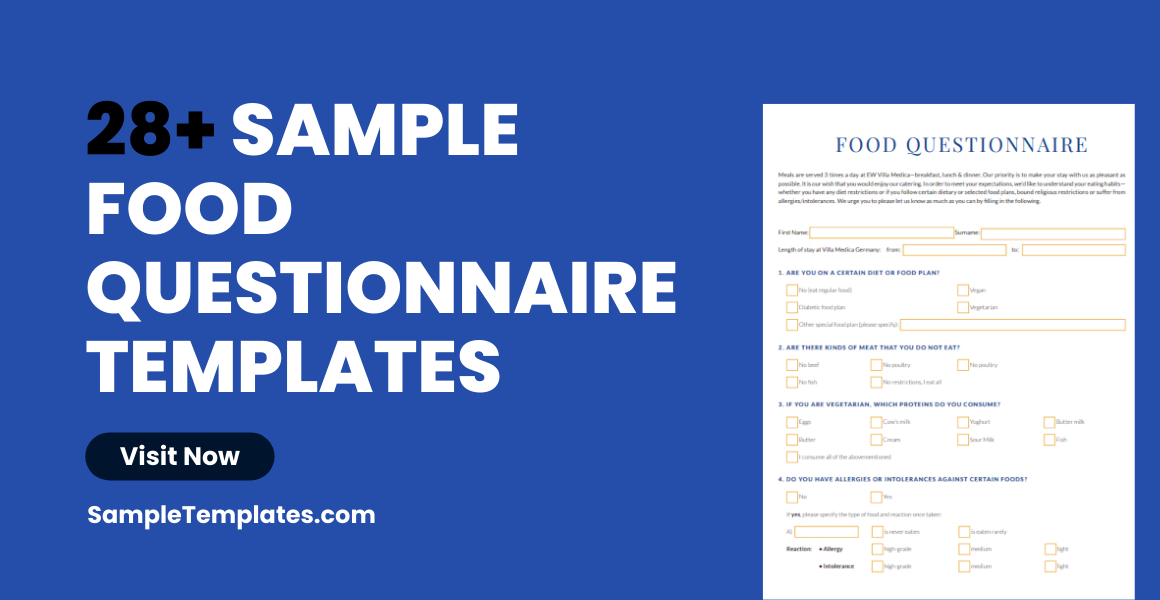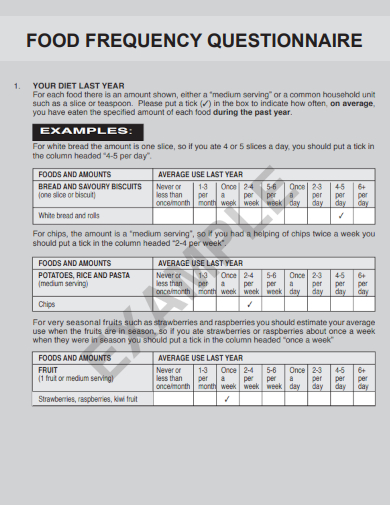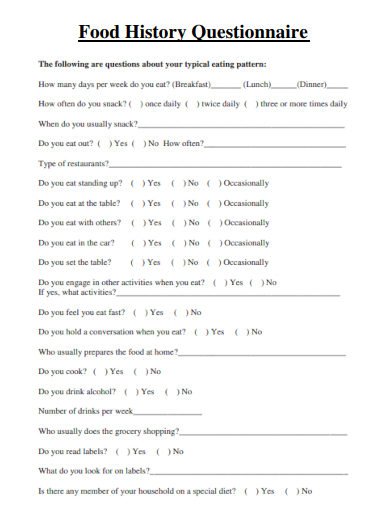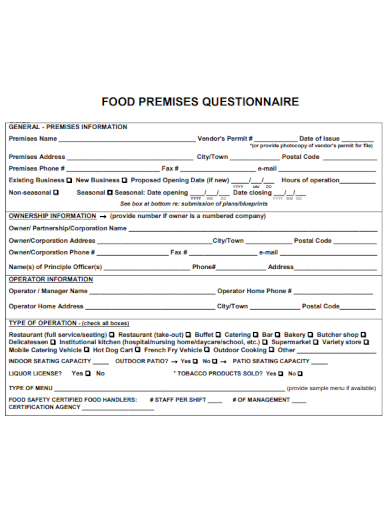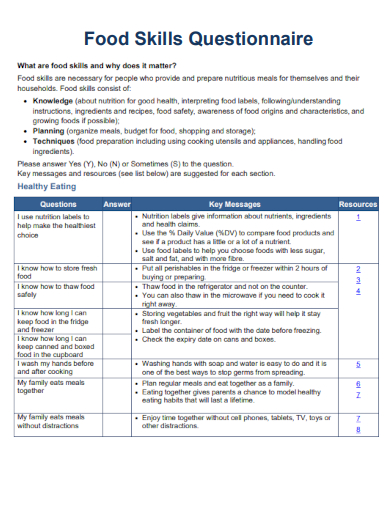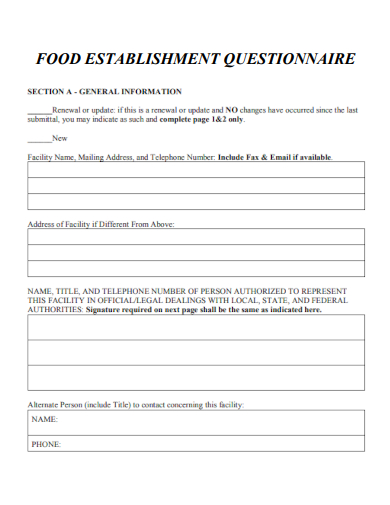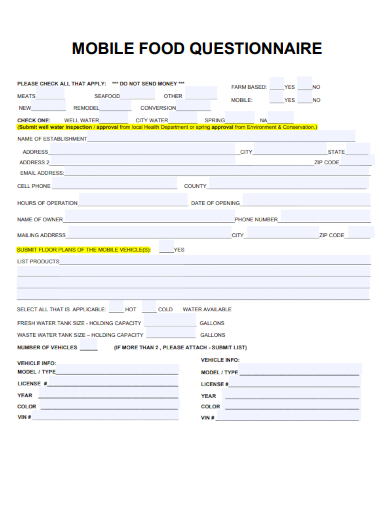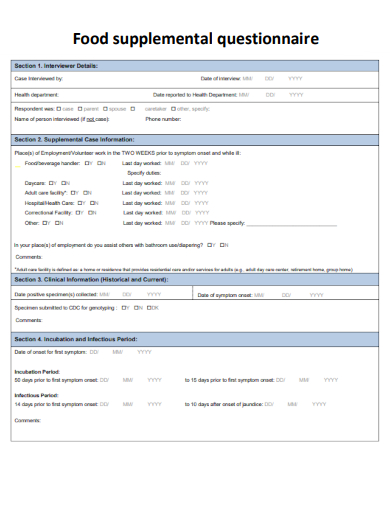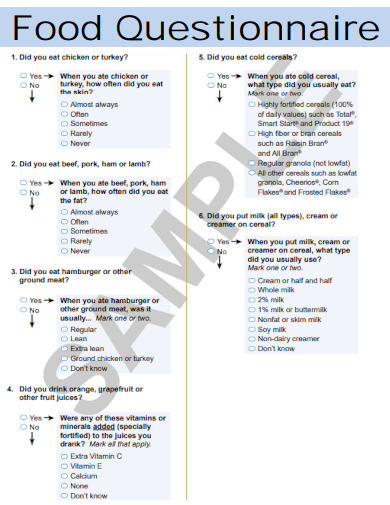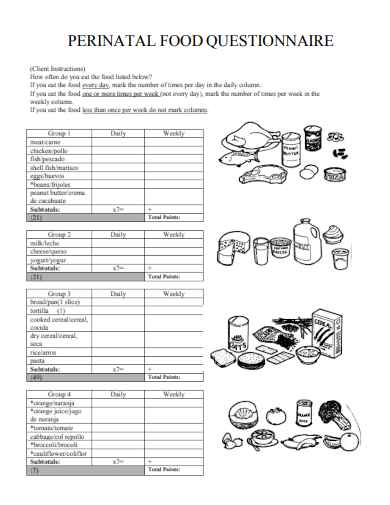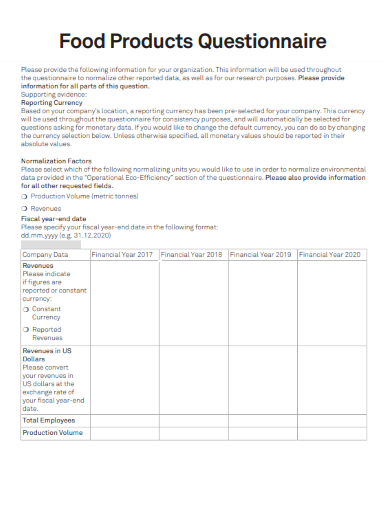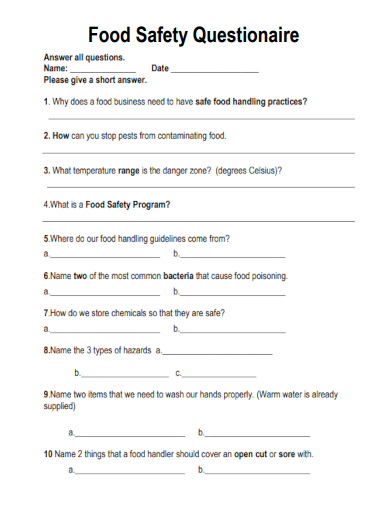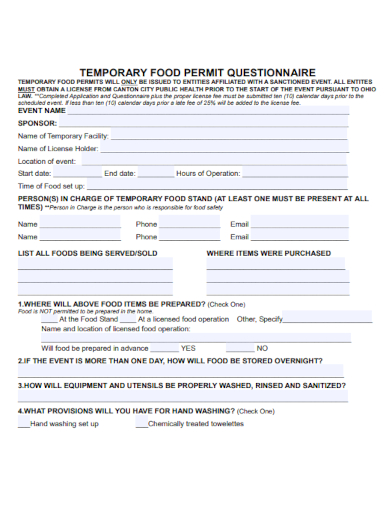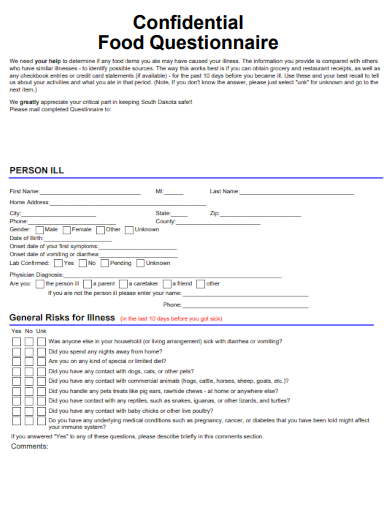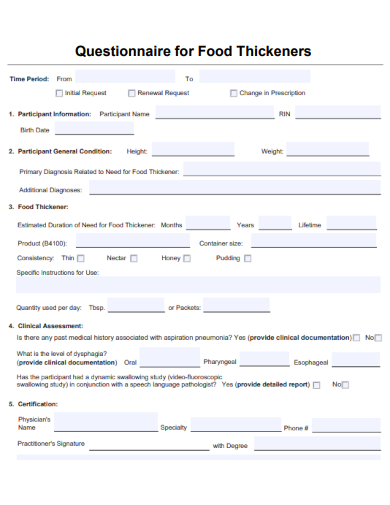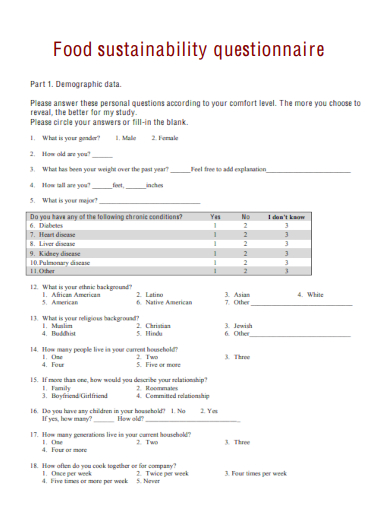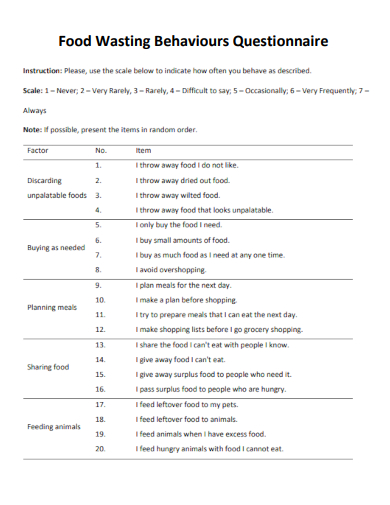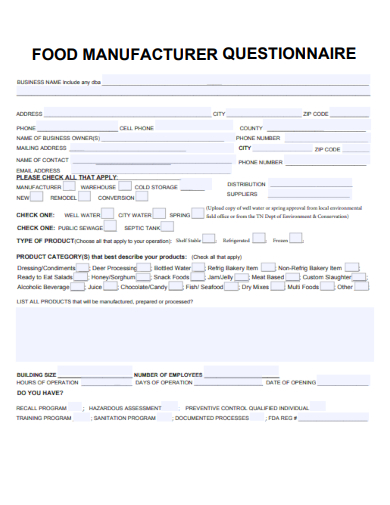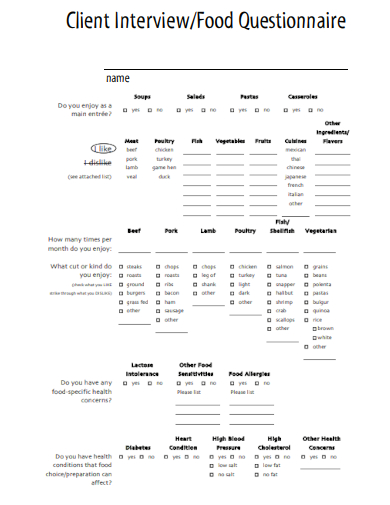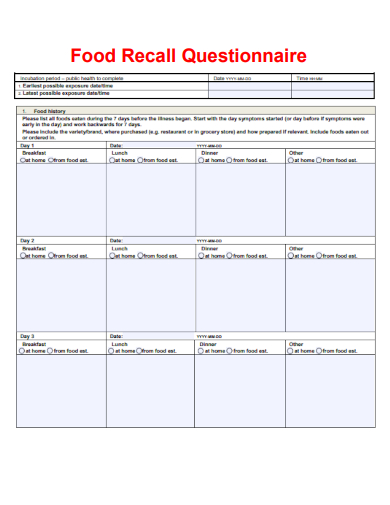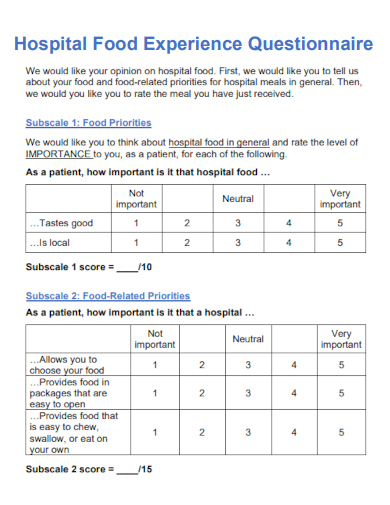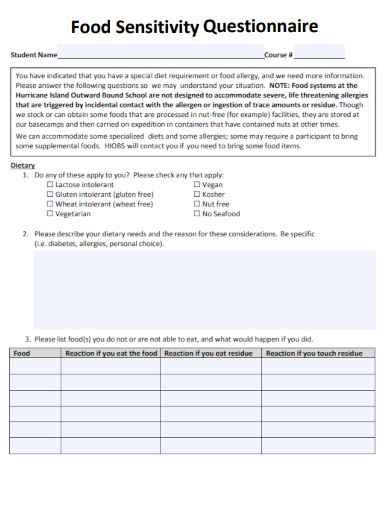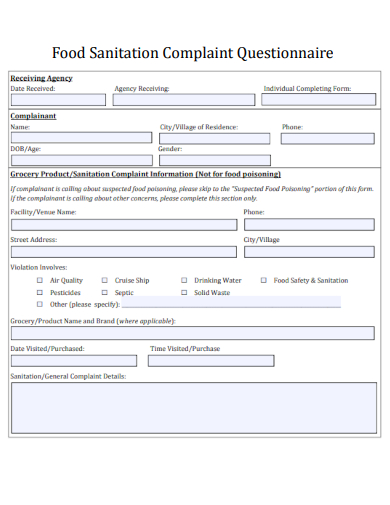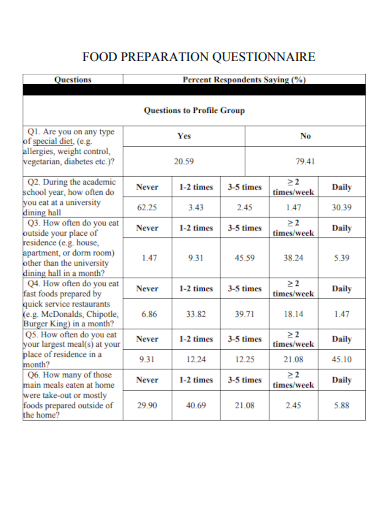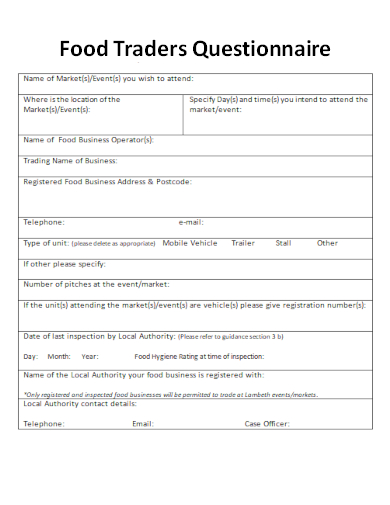Savor the intricacies of dining dynamics with our Sample Food Questionnaire Template. Tailored for epicureans, culinary professionals, and study enthusiasts, this tool delves into the nuances of eating habits, dish delights, and kitchen escapades. If you’re charting new gastronomic territories or measuring diner inclinations, this questionnaire sample is your compass. Embark on a journey into the heart of culinary preferences today!
FREE 28+ Food Questionnaire Samples
1. Sample Food Questionnaire Template
2. Sample Food Frequency Questionnaire Template
3. Sample Food History Questionnaire Template
4. Sample Food Premises Questionnaire Template
5. Sample Food Skills Questionnaire Template
6. Sample Retail Food Plan Review Questionnaire Template
7. Sample Food Choice Questionnaire Template
8. Sample Food Establishment Questionnaire Template
Creating a Food Questionnaire: A Comprehensive Guide
Food questionnaires are vital tools for gathering information on eating habits, dietary preferences, health concerns, and more. They can be used in various settings, from academic research to restaurant feedback collection. Crafting an effective food questionnaire involves careful consideration of the target audience, clear objectives, and insightful questions. Here’s a step-by-step guide to creating a compelling food questionnaire:
Define Your Purpose: Before anything else, determine the primary objective of your questionnaire. Are you trying to understand the eating habits of a particular demographic? Or perhaps you want feedback on a new restaurant menu? The purpose will guide the type of questions you’ll need.
Identify Your Target Audience: Who will be answering your questionnaire? Understanding your audience will help in framing questions that resonate and are relevant. For instance, questions for a vegan community will differ significantly from those targeting fast-food enthusiasts.
Choose the Right Type of Questions: There are various types of questions you can use:
Closed-ended Questions: These are questions where the respondent picks from a given set of answers. For example, “How often do you consume fast food?” with options like “Daily”, “Weekly”, “Monthly”, etc.
Open-ended Questions: These allow respondents to answer in their own words, providing more in-depth insights.
Scale/Rating Questions: For instance, “On a scale of 1-10, how would you rate our restaurant’s ambiance?”
Keep it Concise: While it’s tempting to cover multiple facets of food and dining in one questionnaire, it’s crucial to keep it concise. A shorter, focused questionnaire is more likely to be completed than a lengthy one.
Avoid Leading or Biased Questions: Ensure your questions are neutral and don’t lead respondents towards a particular answer. For instance, instead of asking “Don’t you think organic foods are better?”, you might ask, “What is your opinion on organic foods?”
Ensure Clarity: Avoid using jargon or complicated words. Questions should be straightforward and easy to understand.
Add Demographic Questions: This helps in segmenting the data later. Questions about age, gender, location, or dietary restrictions can provide context to the responses.
Test Your Questionnaire: Before launching it to a larger audience, test your questionnaire on a smaller group. This will help identify any confusing or irrelevant questions.
Choose an Accessible Medium: Decide whether your questionnaire will be paper-based, online, or via an app. Online tools like Google Forms, SurveyMonkey, or Typeform can be particularly useful for easy distribution and data collection.
Assure Anonymity and Confidentiality: If your questionnaire delves into personal eating habits or health-related topics, ensure respondents that their answers will remain confidential. This assurance can lead to more honest responses.
Analyze and Act: Once you’ve collected the responses, take the time to analyze the data. Look for trends, patterns, and insights that can inform your research or business decisions.
A well-constructed food questionnaire can be a goldmine of insights into people’s eating habits, preferences, and perceptions. By following the steps outlined above, you’ll be well on your way to crafting a questionnaire that not only engages respondents but also yields valuable data. Whether you’re a restaurateur seeking feedback or a researcher exploring dietary trends, a carefully designed questionnaire is a powerful tool in your arsenal.
9. Sample Mobile Food Questionnaire Template
10. Sample Food Supplemental Questionnaire Template
11. Sample Food Questionnaire Basic Template
12. Sample Perinatal Food Questionnaire Template
13. Sample Food Allergy Questionnaire Template
14. Sample Food Products Questionnaire Template
15. Sample Food Safety Questionnaire Template
Understanding the Food Preference Questionnaire
A food preference questionnaire is a specialized survey tool designed to gather information regarding an individual’s or a group’s likes, dislikes, and choices concerning various foods and beverages. By delving deep into individual palates, such questionnaires provide valuable insights into dietary habits, cultural influences on diet, potential allergies, or even evolving food trends. Let’s take a closer look at what a food preference questionnaire entails and why it’s important:
Components of a Food Preference Questionnaire:
Variety of Foods: These questionnaires often list a diverse range of foods, from common items like apples or chicken to more niche or cultural-specific dishes.
Rating System: Respondents typically rate their preference on a scale. For example, they might use a scale from “strongly dislike” to “strongly like” or numerical ratings.
Open-Ended Queries: Besides ratings, there might be sections where respondents can elaborate on specific food aversions or affinities, shedding light on reasons behind their preferences.
Purpose and Applications:
Market Research: Companies, especially in the food and beverage sector, use these questionnaires to understand consumer tastes, thereby aiding in product development or marketing strategies.
Health and Nutrition: Nutritionists and dieticians might use these tools to tailor dietary plans according to an individual’s likes and dislikes.
Academic Research: Scholars exploring eating habits across different demographics or cultures might employ food preference questionnaires.
Benefits:
Personalized Dietary Plans: For health professionals, understanding a patient’s food preferences ensures that dietary recommendations are both healthy and palatable for the individual.
Consumer-Driven Products: For businesses, these insights can be pivotal in developing products that resonate with their target audience, leading to higher sales and better customer satisfaction.
Cultural Insights: On a broader scale, patterns in food preferences can reveal cultural or regional trends, essential for sociologists or anthropologists.
Challenges and Considerations:
Subjectivity: Preferences can be highly subjective and may change over time due to various factors, including exposure to new foods or changing health conditions.
Comprehensive Choices: It’s challenging to include an exhaustive list of foods, especially considering global cuisines. The key is to strike a balance between comprehensive coverage and questionnaire length.
Interpreting Data: Raw preference data needs careful analysis. For instance, a dislike for a particular food might stem from dietary restrictions, past experiences, or cultural beliefs.
How It Differs from Dietary Assessment Tools:
While both tools deal with food, a food preference questionnaire specifically gauges likes and dislikes. In contrast, dietary assessment tools generally measure food intake, providing quantitative data on nutrient and calorie consumption.
In conclusion, a food preference questionnaire is a powerful instrument, granting a window into the complex landscape of individual and collective food choices. Whether you’re a health professional tailoring meal plans, a company innovating the next best-selling snack, or a researcher delving into the intricate web of cultural dietary habits, this tool offers a trove of valuable insights. Properly designed and effectively interpreted, it can illuminate the multifaceted world of food preferences, helping craft strategies, solutions, and studies that resonate deeply with the target audience.
16. Sample Temporary Food Permit Questionnaire Templates
17. Sample Confidential Food Questionnaire Template
18. Sample Questionnaire for Food Thickeners Template
19. Sample Food Sustainability Questionnaire Template
20. Sample Food Wasting Behaviors Questionnaire Template
21. Sample Food Manufacturer Questionnaire Template
22. Sample Change of Food Facility Owner Questionnaire Template
23. Sample Client Interview & Food Questionnaire Template
24. Sample Food Recall Questionnaire Template
25. Sample Hospital Food Experience Questionnaire Template
26. Sample Food Sensitivity Questionnaire Template
27. Sample Food Sanitation Complaint Questionnaire Template
28. Sample Food Preparation Questionnaire Template
29. Sample Food Traders Questionnaire Template
The 5 Factor Food Questionnaire: An In-depth Overview
The 5 Factor Food Questionnaire (FFFQ) is a recognized tool utilized in nutritional and psychological research to assess eating habits and dietary patterns, particularly those related to the intake of specific nutrients and the risk of chronic diseases. The ‘5 factor’ component does not specifically refer to only five questions or five foods but rather focuses on capturing a broad picture of dietary habits.
Origins and Development
The FFFQ was developed in response to the need for a reliable and efficient tool to gather detailed dietary information without the extensive time commitment of other methods, such as food diaries. It aimed to provide a compromise between detail and feasibility in large-scale studies, ensuring accuracy without compromising the willingness of participants to complete the survey.
Key Characteristics
The primary characteristics of the FFFQ are its focus on frequency rather than quantity and its emphasis on foods relevant to specific health concerns or nutrient intakes. Instead of asking respondents to recall exact quantities of food consumed, the FFFQ typically inquires about how often certain foods are eaten over a specific period, such as a week or month. This method has the advantage of simplicity, making it easier for participants to respond and reducing the potential for recall bias.
Applications in Research
The FFFQ has been employed in various studies, including those investigating the links between diet and chronic diseases like heart disease, diabetes, and certain cancers. Its design makes it particularly useful for identifying dietary patterns that might elevate or reduce the risk of these conditions. Moreover, the FFFQ can be tailored to target specific populations or dietary concerns, making it adaptable to various research needs.
Strengths and Limitations
One of the main strengths of the FFFQ is its ease of use, both for researchers and respondents. Its focus on frequency over quantity simplifies data collection and analysis. Additionally, its adaptability means it can be modified to address specific research questions or target groups.
However, like all dietary assessment tools, the FFFQ has its limitations. Its reliance on self-reported data can introduce biases, especially if respondents inadvertently overestimate or underestimate their food consumption. There’s also potential for inaccuracies due to the generalized nature of frequency-based questions, which might not capture the nuances of individual diets.
Incorporation into Broader Assessments
Often, the FFFQ is not used in isolation. It’s typically combined with other dietary assessment tools or incorporated into larger health surveys. This combination approach allows researchers to cross-check and validate data, enhancing the reliability of findings.
The 5 Factor Food Questionnaire stands as a testament to the ever-evolving methods used in dietary and nutritional research. By balancing detail with feasibility, the FFFQ provides a practical tool for capturing a snapshot of dietary patterns, enabling researchers to draw connections between food choices and health outcomes. As with any research method, understanding its strengths and limitations is key to harnessing its full potential and interpreting its results with the necessary nuance.
Related Posts
Sample Business Card Templates
Sample Cashier Job Descriptions
Questionnaire Samples
FREE 10+ Sample HR Resource Templates in PDF
FREE 10+ HR Consulting Business Plan Samples in MS Word | Google Docs | Pages | PDF
FREE 49+ Sample Job Descriptions in PDF | MS Word
FREE 16+ Nonprofit Budget Samples in PDF | MS Word | Excel | Google Docs | Google Sheets | Numbers | Pages
FREE 13+ Academic Calendar Templates in Google Docs | MS Word | Pages | PDF
FREE 10+ How to Create an Executive Summary Samples in Google Docs | MS Word | Pages | PDF
FREE 23+ Sample Event Calendar Templates in PDF | MS Word | Google Docs | Apple Pages
Company Profile Samples
FREE 10+ Leadership Report Samples [ Development, Training, Camp ]
FREE 24+ Sample Payment Schedules in PDF | MS Word
FREE 10+ Return to Work Action Plan Samples in PDF | DOC
Autobiography Samples & Templates
